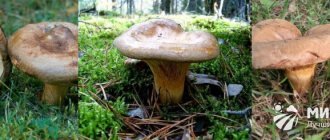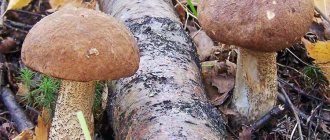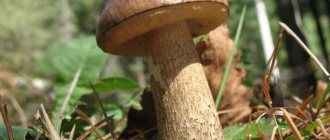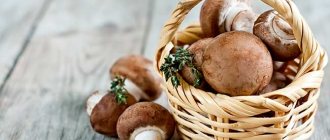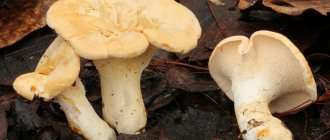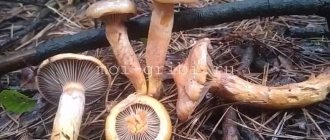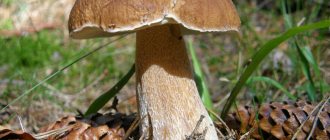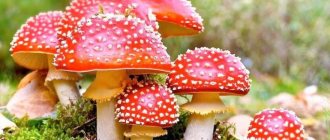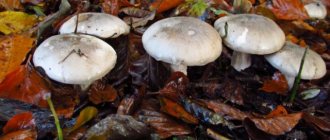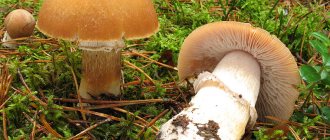Dunka mushrooms grow everywhere in our country and are known under different names. The most common of them is pig. This species was considered conditionally edible a few decades ago and belonged to category 4. This classification meant that dunka mushrooms were allowed to be eaten, but only after long-term processing. It was customary to cook them for a long time. Some housewives, before preparing pigs, soaked the fruiting bodies in cold water for 3-4 days, constantly draining it. The mushrooms were then fried, pickled or salted.
However, relatively recently, scientists were able to prove that dunki contain a complex toxin that is not destroyed by high temperature. Soaking also does not make the mushroom safe for health. A toxic substance can have a destructive effect on red blood cells, changing blood counts.
It disrupts the functioning of the gastrointestinal tract, causing poisoning, which manifests itself in the form of diarrhea, abdominal pain and vomiting. In severe cases, eating pigs can lead to acute kidney failure and even death.
There is no effective antidote yet. The consequences of exposure to the toxin contained in mushrooms are treated with supportive and symptomatic therapy. Sometimes the patient is connected to a hemodialysis machine to quickly remove the poison from the body and normalize kidney function. This fungus is especially dangerous for children, elderly people and people with reduced immunity.
What does a pig look like?
A detailed description of the pig mushroom helps to accurately identify this type of mushroom, so as not to collect it together with edible ones. The biggest difficulty is that dunka does not have the characteristic signs of poisonous varieties. But the mushroom still has some distinctive features that make it stand out in a forest clearing.
Pigs grow in large groups. They usually spread in forest edges or swampy areas. The sizes of young and adult mushrooms vary greatly. The hat can reach a diameter of 4 to 15 cm. It has a fairly bright color. Small young mushrooms are usually orange-brown, while older ones take on a rusty tint. The surface of the dunka in dry weather can be smooth with slight pubescence; after rain it becomes dull and slightly sticky.
The pig's hat changes throughout life. At first it is round, convex, fleshy, with slightly concave edges. As this species matures, it develops a flattened top that collapses in the center. The stem of this mushroom is quite short. It has a solid matte structure and a gray-brown tint.
Svinushka does not have a pronounced mushroom smell and taste. Its pale yellow flesh is quite dense, juicy and soft. The plates under the cap are thin and thick. They are well separated from each other and from the fruiting body.
Photos of duneks may be different. The appearance of this mushroom largely depends on the place where it grows. Most often it can be found in deciduous and coniferous forests next to fallen trees and on stumps.
This mushroom loves moisture and is able to accumulate it in the pulp. Therefore, the easiest way to identify a pig is to press on the base of the cap or a cut of the fruiting body. If we are talking about a dangerous species, the mushroom will darken.
Dunki are very unpretentious. They can be found in any region where there is sufficient moisture for their growth and development. The period of active fruiting is from late June to October. Therefore, throughout the summer-autumn period, mushroom pickers must be careful while collecting these forest gifts. Before you go on a quiet hunt, it is better to carefully study the photos of poisonous mushrooms again, so as not to risk your health and the well-being of your loved ones.
What to do in case of poisoning?
The peculiarity of dunka is that with small quantities eaten over a certain period of time, damage to the body occurs gradually and can resemble an intestinal infection. Even if the poison continues to enter the blood in small doses, the autoimmune response of the human defense system is usually not enough to suppress the destructive effects of the toxin.
The first to prove the deadly danger of mushrooms of the pig family was the German researcher Julius Schaeffer. The cost of discovery was too high: the mycologist died of kidney failure 3 weeks after eating this species. A sad event occurred at the beginning of the twentieth century, but only in 1981 did the authorities officially recognize that dunki have a high degree of toxicity.
A large amount of mushrooms eaten can cause the first signs of poisoning within a few hours. But symptoms can appear gradually over a longer period of time. This is where the danger lies. After a few weeks, a person may no longer remember what could have caused the illness.
Laboratory tests usually show abnormalities in all blood counts, especially the red blood cell count. The patient, as a rule, increases indirect bilirubin, provoking the development of jaundice. A doctor can diagnose symptoms of acute kidney failure. In this case, hospitalization of the patient is required. A person needs round-the-clock observation in a hospital setting.
Since there is no antidote, the consequences of pig poisoning are eliminated with the help of antihistamines, drugs that normalize blood counts, and in especially dangerous cases, hemodialysis is used.
To avoid mortal danger, you should not collect questionable mushrooms, as well as edible species growing near large industries or along roads. Otherwise, a harmless activity can lead to very sad consequences.
Post Views: 163
Dunka is a mushroom that belongs to the pig family. Previously, it was considered conditionally edible and was eaten. However, it is now classified as a poisonous macromycete. In some modern reference books in the description you can find the definition as deadly poisonous. The people called him “Dunka”. The mushroom also has a scientific name: Several deaths have been recorded in the Russian Federation after eating it.
Dunka mushrooms contain lectins. They may also contain muscarine. These substances are not destroyed during heat treatment. Even repeated boiling, which some mushroom pickers resort to, does not help. After frequent consumption of these macromycetes in food, people may experience changes that are dangerous to life and health.
Dunka is a mushroom that should not be eaten regularly. Under the influence of harmful substances in the blood, the formation of agglutinin antibodies begins, which react to macromycete antigens (this does not mean occasional doses, but constant ones). Agglutinins accumulate in the body over time. When their number exceeds a certain threshold, they begin to destroy red blood cells.
Experts say that the period of onset of poisoning depends on the characteristics of a particular organism. Someone constantly eats thin pigs, and poisoning occurs only after a few years. However, some people have increased sensitivity to agglutinins, so poisoning can occur immediately and be fatal. This macromycete is more dangerous than the traditional ones known to everyone. Although many mushroom pickers do not recognize this and consider dunka to be conditionally edible. Eating this mushroom in combination with alcohol significantly increases the level of toxins in the blood.
Description
The mushroom cap has a diameter of 3-12 cm. Initially it is convex (the edges are felted and rolled up), and then depressed and flattened, slightly funnel-shaped. The edge is drooping, straight, ribbed or ribbed, often fibrous. The surface of the cap is velvety, dry, and in wet weather it is sticky and shiny. Its color is olive-brown or ocher-brown, darkening when pressed. Dunka is a mushroom that has medium, ocher-brown descending plates, somewhat lighter in color than the cap. They also darken when pressed. Spore powder is brown. The stem of this macromycete is short (cylindrical), smooth, sometimes narrowed towards the base, up to 2 cm in diameter and up to 6 cm in length. Its color is lighter than the cap. The pulp, at first dense and soft, becomes loose over time. Its color is yellowish-brown, darkening when broken and cut. Dunka mushrooms (photos of them need to be carefully studied) are often wormy, like other certainly edible gifts of the forest.
Habitat
Dunka is a mushroom that can be found in the forest from mid-June to November. This macromycete can be found in forests and shady, damp places. It is often found in open forests, park areas, vegetable gardens, and sometimes even on tree trunks. This mushroom grows singly and in families. Prefers shrubs, young birch trees, oak trees. It can be found on the outskirts on the edges, not far from mossy pines and spruces.
Two weeks of continuous rain, downpours, thunderstorms and not warm at all :-( But time flies inexorably - it’s time!
Next Sunday we visited the Second Site. There is still nothing to the nearest forest, but along the field there are insurmountable puddles. We overcame one puddle using a detour through a forest belt, but it was not possible to get to the second section itself - it was too dirty and damp. And - just yesterday, the most impatient ones wanted to drive through - they made quite deep ruts with slipping wheels.
There are mushrooms in the second area! True, they are, as usual, on the far side. Where few reach.
Basically these are dunki. Most are large, fluffy, overgrown.
Boletus mushrooms are also found. Mostly, again, outgrown, everything from the first wave, it seems.
However, the new ones have already arrived!
In about two hours, a bucket with a large pile filled up - quite normal for the first trip.
There is a lot of grass in the forest. And the strawberries went well -
In total there was a bucket and a bucket and a half basket. There are about a bucket of boletus mushrooms, the rest is dunki (or svinushki, if in scientific terms).
We got back without incident. The boletus mushrooms were almost immediately fried and consumed, with dunki being more difficult.
Since these are conditionally edible mushrooms, as they are usually classified, they must first be thoroughly soaked in water. Pre-cleaning of leaves and other debris. Then -
A unique recipe for pickling dunek (pig,
if in scientific terms):
When salted like this, the mushrooms turn out just classic - you'll lick your fingers! We have been using this recipe for many years - no problems have arisen, and therefore we recommend it.
Since salting without vinegar, it is better to store pickled mushrooms in this way for no more than a month. Although - if it is in a sterilized jar and rolled up - you can use it after a year - it has been tested.
Good luck on your mushroom hunt!
Every experienced housewife has her own unique recipe for salting pigs. These unpretentious mushrooms grow in groups in coniferous and deciduous forests, sometimes they can be seen even within the city.
Svinushki is a collective name; more than 8 species are known. Among them there is thin and thick, and the first is more common. They are similar in appearance to saffron milk caps, with the difference that the latter have milky juice.
A characteristic feature is the presence of a deep depression on the cap. The structure is tight, almost instantly darkening when cut. The taste is bitterly sour.
Svinushki contain numerous trace elements such as magnesium and potassium. It is worth noting that until the early 80s they were classified as conditionally edible. The fact is that many experts believe that pigs have the ability to accumulate heavy metals in the body, which cannot be removed. There is another point of view, according to which this type of mushroom has the ability to stop the development of tumors, as well as a powerful antibiotic effect.
However, salted pigs are very popular. This is a wonderful dish, appropriate both for a festive feast and as an addition to everyday first or second courses.
Preparing to cook
Svinushki are considered one of the most delicious mushrooms. But to avoid poisoning, they must be properly processed before cooking.
Clean the mushrooms from adhering leaves, grass and other debris, then put them in cool water and soak for at least an hour.
Cut into small pieces and boil for 20 minutes. After the water boils, the pigs will change their appearance and turn black. Don't be scared, this is normal.
Only after boiling can they be cooked.
Not great for soups or frying. That is why many mushroom pickers do not collect them, because they do not know what can be prepared from them. Meanwhile, pigs are ideal for salting.
The mushrooms should not be too large, as the caps will spread; it is advisable to use medium-sized ones.
You need to use pigs, especially thin ones, immediately after collection, as they disappear very quickly, especially thin ones, and worms can get into them.
Before you begin the pickling process, the mushrooms need to be immersed in cold water with a little salt added and left for a day. The water should be changed several times.
Salt in glass jars or enamel dishes. Wooden barrels and tubs are suitable. But you should not use earthenware. The fact is that under the influence of salt, the coating can be destroyed, and harmful substances will enter the mushrooms.
A few words about cowsheds
Cowsheds (or pig sheds) grow in clearings illuminated by the sun. It is not recommended to take a mushroom that has grown near the roadway, as it will contain many harmful substances, which increases the risk of poisoning. The barns need to be prepared immediately, as they are not stored for a long time (they turn black, mold, and so on).
Before cooking, the mushrooms are soaked in water for a while and then cooked. It should be noted that barnyard mushrooms, the recipes for which we will consider below, are not recommended to be dried and added to soups; they are usually pickled and pickled. To do this, choose wooden barrels or containers made of glass and ceramics.
Cold pickling recipe for the winter
Ingredients:
Svinushki – 1 kg; Salt – 2 tablespoons; Dill sprigs and black currant leaves - 3-5 pieces; Peppercorns – 6 pcs.; Garlic – 5-6 cloves.
Preparation:
The cold method recipe does not involve heat treatment.
To begin with, the pigs are filled with cold salted water for a day; the water needs to be changed approximately every 5 hours. This is necessary in order to remove the bitter taste. It is advisable to keep in a cool room.
After soaking, the mushrooms are placed in jars and sprinkled with salt, a press is placed on them and left in a cold, dark place, for example, in a cellar.
After 30 days, salted pigs can already be eaten.
Hot salting method
Ingredients:
Svinushki – 1 kilogram; Currant leaves – 4-5 pcs.; Seasonings: cloves, black peppercorns, garlic, bay leaf, salt, spices.
Preparation:
Clean fresh pigs from debris, trim off the legs that are not edible. Rinse, put in a container and fill with cold water and salt. Leave for a day.
Boil the mushrooms in highly salted soda for 30 minutes, skimming off the foam during cooking.
Drain in a colander and rinse. Boil a second time, since once is not enough, you need to remove all toxins.
Add salt (to taste), sugar and seasonings to the water in which the pigs are boiled. Cook in brine for 15 minutes.
Place seasonings in sterilized jars; many housewives add horseradish and cherry leaves in addition to currant leaves. Place the mushrooms and add the water in which they were boiled. Close the jars with tight nylon lids. To avoid such a dangerous disease as botulism, it is not recommended to roll up jars with iron lids.
It is better to salt it in a saucepan, but if there are a lot of pigs, you can salt them for the winter in a wooden tub. To do this, process them as described in the recipe above. Lay out the mushrooms, sprinkle with seasonings, cover with several layers of gauze, put a wooden circle, put pressure on it.
After a month you can eat.
Hot-salted pigs turn out to be incredibly tasty and aromatic.
Pickled cowsheds
Ingredients: half a glass of table vinegar, two tablespoons of salt, ten cloves of garlic, five stalks of dill, two bay leaves, as well as five black peppercorns, two spoons of sugar, a pinch of cinnamon.
Before cooking barnyard mushrooms, you need to soak, wash and cook them. Boil in salted water for about twenty-five minutes, periodically removing any foam that appears. After this, remove the mushrooms from the heat and cool. Place the pigs into jars prepared in advance, pour in the cooled marinade, add two tablespoons of sunflower oil and roll up.
Salting pigs in olive oil for the winter
Ingredients:
Medium-sized pig mushrooms - 1 kg; Vinegar – 0.5 l; Olive oil – 3 cups; Seasonings, bay leaf, black pepper, salt, garlic.
Preparation:
Prepare the pigs for salting in the same way as in previous recipes. Place in a large enamel pan, add salt, vinegar and cook for 10 minutes.
Drain the water and rinse the mushrooms.
Pour olive oil into a frying pan and add mushrooms there. Fry them with the addition of spices. After this, place in clean, sterilized jars and close.
This savory recipe will appeal to even the most discerning gourmets and lovers of unusual combinations. Svinushki have a light sour taste and go well with other dishes, such as boiled potatoes and meat.
Cow lip meat. Types of meat products in a dog’s diet and their consumer properties.
Meat products for dogs, dry food, natural or mixed feeding are issues that are most often and passionately discussed on forums and portals. There are many opinions, many articles on this matter, including on our website.
For example:
- Natural food for dogs.
However, the decision itself, as well as the responsibility for it, lies with you! It is the dog’s owner who makes his choice and is entirely responsible for it.
Muscle meat.
Storage conditions
Pickling mushrooms correctly is one thing, but it is important to follow the rules for storing them so that they do not disappear over the winter.
If salted pigs are stored in a warm room where the temperature exceeds 6 degrees Celsius, then rest assured that they will quickly lose their taste and spoil. Also make sure that the room is not too cold; the mushrooms will freeze, which will negatively affect their taste and structure - they will break.
Pork salted in a wooden tub spoils the fastest. Sometimes the tree begins to mold; to get rid of the accumulation of fungus, you need to wipe the damaged areas with hot salt water. It is not recommended to wrap or cover the tubs; such measures will quickly lead to mold.
You need to monitor the amount of liquid; if it is not enough, then you just need to add cold boiled water.
The taste of pigs depends on the amount of salt in the solution. If there is a lot of it, then the mushrooms will be too salty, no matter how you wash them later. If there is not enough salt, they can ferment. There are many recipes for making salted pigs for the winter; we have presented the most popular and simple ones. Every housewife can make many adjustments to the cooking method, experiment with seasonings and ingredients and improve the recipe.
Dunka mushrooms have several names: fetyukha, cowshed, pigs, tonka svinushka, solokh and duni. They have fleshy and dense flesh, which makes them popular among gourmets.
Paxillus involutus, as the mushroom is designated in the scientific literature, belongs to the pig family. Although the pig does not have any signs of poisonous varieties, it still contains dangerous substances that are destroyed under the influence of heat treatment.
According to the description, the mushrooms are similar to milk mushrooms.
They prefer to grow in large groups. Usually found in swampy areas or forest edges. In dry weather, the surface of the mushrooms is smooth with slight pubescence, which when wet becomes sticky to the touch and matte.
Svinushka does not have any signs of poisonous varieties, but still contains dangerous substances that are destroyed under the influence of heat treatment.
Depending on age, the size of individuals varies. Fleshy caps of bright orange-brown color can grow from 4 to 15 cm, which change throughout life not only in size, but also in shape. A cap flattened at the top is formed from a round and convex shape. The leg of Dunka has a matte structure and gray-brown color and is quite short (up to 10 cm).
The taste and smell of mushrooms are not very pronounced.
The pulp is characterized by a dense structure and light yellow color. When pressed, juice is released. Under the cap there are thin and thick plates, similar to folds, which are easily separated from the surface.
Description of the structure of the fruiting body
The tinder fungus has an unusual structure. The body of the mushroom is very resistant to various influences: water, heat, frost.
Thin threads, hyphae, intertwined with each other, form the body of the fungus. The mycelium or mycelium is hidden deep in the tree trunk. Hyphae penetrate the tree bark by secreting enzymes that easily dissolve the cell membranes of woody tissue anywhere. The hyphae range from the thinnest and thread-like to skeletal and thick. According to their shape, fruiting bodies are divided into:
- sessile (only one side is attached to the substrate, sometimes they have a lateral leg);
- prostrate (look like a plate or cake, tightly adhered to the tree, the color and surface of which often resembles tree bark);
- having a cap and a stem.
May differ within the same genus or family.
The tinder fungus uses wood as a substrate.
Where and when to collect dunki
You can go looking for pigs from the end of spring
and collect them before the temperature drops. Since this species loves damp and shady places, colonies of fungi are found under trees (oak, birch, coniferous varieties), shrubs, on mosses, in forests, and sometimes on trunks. Dunki are rarely found alone, so even from one clearing you can leave with a full basket of harvest.
Experienced mushroom pickers advise cutting off young specimens, since at this time they have elasticity. A distinctive feature of young mushrooms is their small size and slightly shaggy cap. The inside of old dunikas is loose.
The negative properties of dunekas include significant absorption of chemicals, radioisotopes and heavy metals from neighboring fields and nearby roads. Due to this feature, it is prohibited to collect dunki growing near industrial enterprises and highways.
Experienced mushroom pickers advise cutting off young specimens, since at this time they have elasticity.
What to do with dunki after collection
Although, unlike other mushrooms, dunki suffer less from worm invasion, they still need to be sorted out.
- It is necessary to remove overripe, dry or spoiled mushrooms, as well as leaves and other debris.
- To check for pests, you need to trim the bases of the legs. It is not necessary to remove the skin from the cap, like butterfish. If dirt has stuck to it, just scrape it off with a brush or knife.
- The sorted crop must be filled with cold water with the addition of a small amount of salt. This composition makes it easier to clean debris from mushrooms. After half an hour, the pig can be washed and placed in clean water for another 30 minutes.
- The water should be changed at least three more times, with an interval of several hours. This procedure allows toxins and harmful substances to leave the product.
Since ancient times, thin pork has been eaten in Rus'
- After the last soaking, the mushrooms must be sorted by size and the stems separated from the caps. It is recommended to leave small mushrooms whole, and cut larger caps into pieces.
- Before preparing a dish of duneks, they should be boiled for half an hour with the addition of salt. Since mushrooms contain pigment, the water and the mushrooms themselves will darken during cooking. Then the water must be drained and the dunki rinsed well. Then pour clean salted water again and keep on fire for another 30 - 40 minutes.
- The final step is straining the mushrooms. Ready-to-cook pigs can be fried or salted (marinated) using the hot method.
Despite the fact that experienced mushroom pickers use pig mushrooms in preparing various dishes, medicine refutes the fact that they are harmless
Fried cows with sour cream
Ingredients: five hundred grams of young mushrooms, half a glass of sour cream, as well as hard cheese, garlic, onions, parsley and basil, apples, salt and spices to taste, vegetable oil or pork fat.
Before cooking barnyard mushrooms, they should be cleaned and boiled. Then they are washed and cut into pieces. Place cowsheds in a heated frying pan in fat or vegetable oil and fry them for fifteen minutes, avoiding overdrying. Next, add onions and seasonings, but do this sparingly to preserve the mushroom flavor and aroma. Mushrooms should be salted at the end of frying, but before that, sour cream is added to them. Then the dish is simmered until fully cooked. If more sauce is required, dilute the sour cream with milk or mushroom broth. The dish can be served either hot or cold.
Should you eat dunka mushrooms?
Despite the fact that experienced mushroom pickers use pig mushrooms in preparing various dishes, medicine refutes the fact that they are harmless. Dunek contains an antigen that causes the formation of antibodies in the blood that destroy red blood cells
. Unlike other poisonous mushrooms, poisoning of the body may not occur instantly, but after many years of using them as food.
Toxins accumulate over a long period of time and, depending on the body’s sensitivity, gradually destroy red blood cells. When red blood cells break down, the process of hemolysis occurs (the release of hemoglobin). As a result, kidney and liver damage occurs and, as a result, anemia and hepatitis. Often the patient does not even know the causes of the disease. Experts say that heat treatment does not destroy toxins and does not convert them into an edible product. Frequent consumption of mushrooms in food changes the composition of the blood, leading to a threat to health and even life.
Children are especially sensitive to toxic substances.
